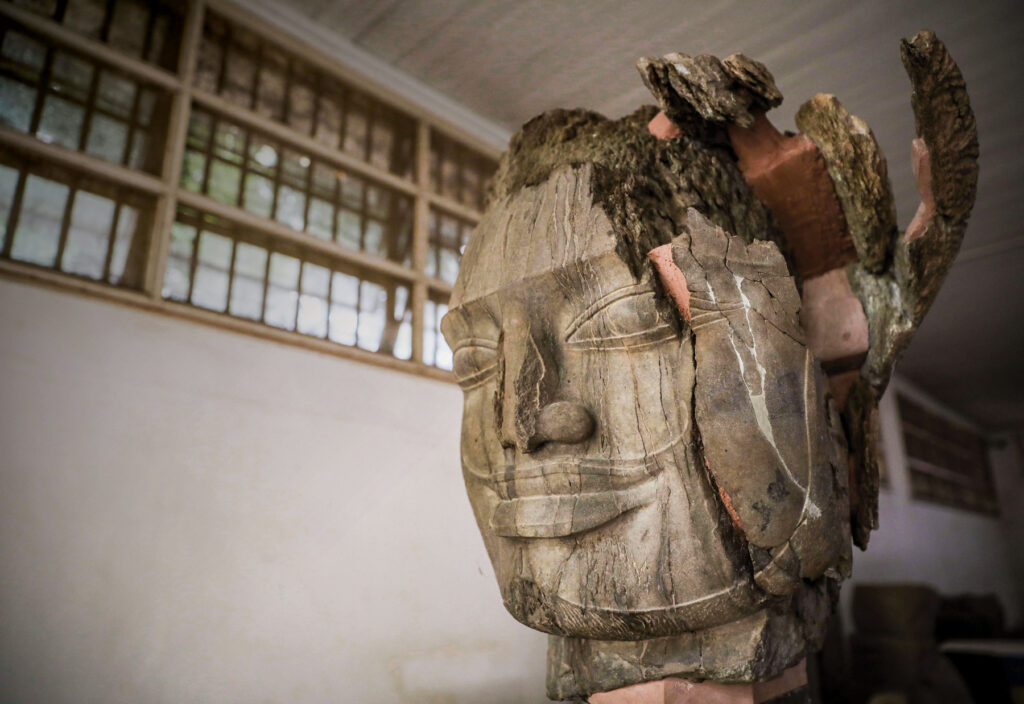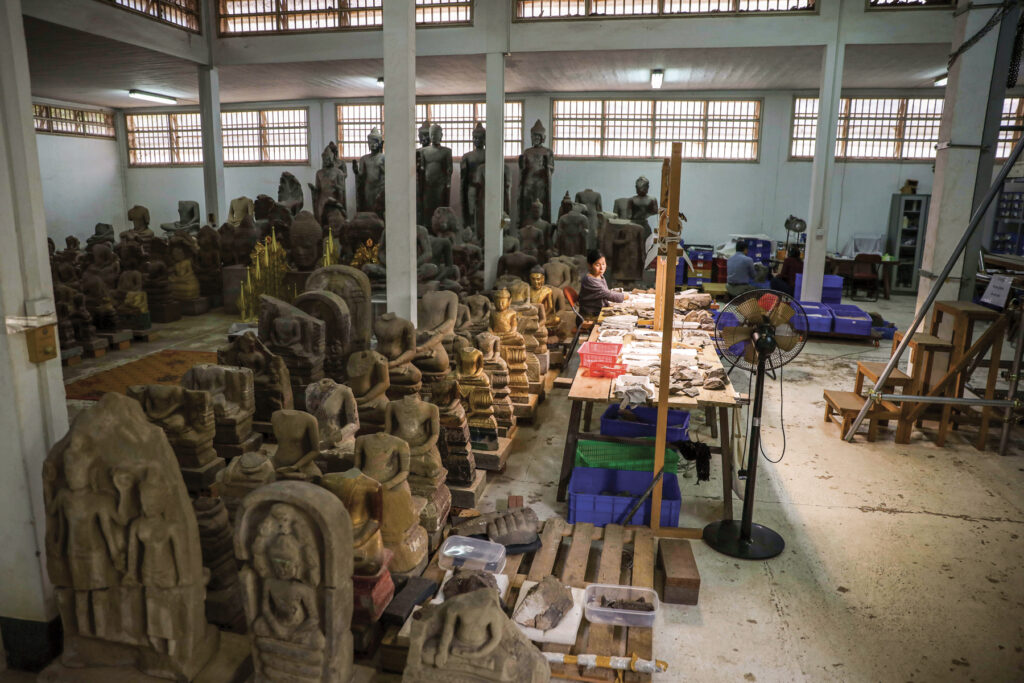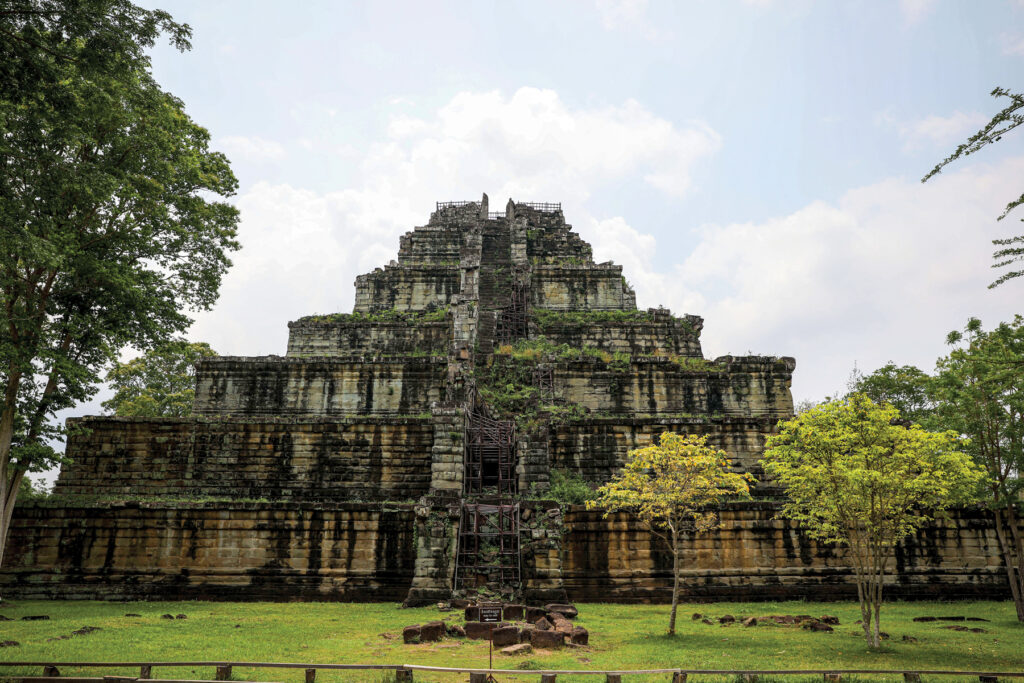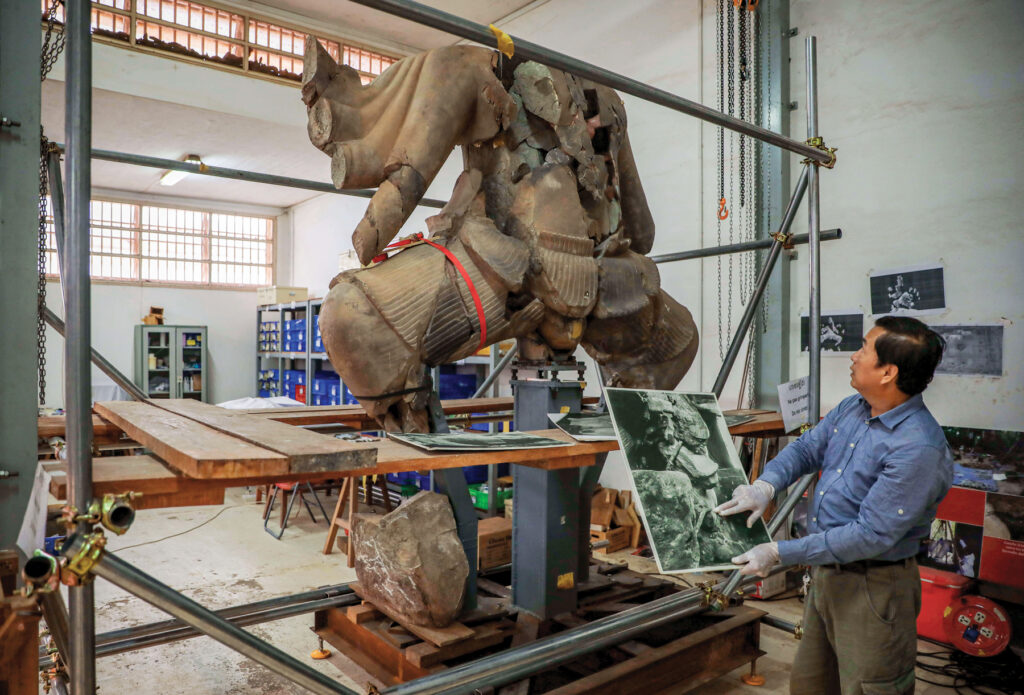The return of Cambodia's cultural heritage, looted and destroyed over decades, is celebrated at home. Many of its lost treasures must be restored in a painfully slow process

Hundreds of headless deities sit in rows in a warehouse in Siem Reap, lit by buzzing fluorescent lights and a rim of small windows.
The largest statue, nearly five metres tall, looks down at the rest. Or, rather, it would look down if it still had its head. Five heads, in this case.
Stone restorers and archaeologists have spent more than a decade piecing back together the monumental statue of the Hindu god Shiva from the Koh Ker temple complex in northern Cambodia, added to UNESCO’s World Heritage List in September 2023. The seven-tonne, 10th-century work depicts a 10-armed Shiva in a dancing pose. But over long years of turmoil during the country’s civil conflict in the 1980s and ‘90s, looters gradually smashed the stone deity into more than 10,000 pieces.
Some larger fragments, including two of the heads, had been preserved in Phnom Penh before the 1970s. A third head was shattered before vandals got to it, and the final two looted faces have yet to be found.
Starting in 2020, the world has shone a spotlight on the return of looted relics to Cambodia, with federal indictments in the US preceding returns from the Denver Art Museum and wealthy private collectors such as Netscape founder Jim Clark. The arrivals in the country met a joyous response, though much of the fanfare stopped at the point
of repatriation.
Even intact objects require deep historical research to fully understand their place in Khmer history. The quiet restoration of the dancing Shiva by a team of French and Cambodian experts demonstrates the often tedious, highly difficult process of piecing the country’s looted history back together.
The shattered statue now stands behind the gates of Angkor Conservation, an office of the Ministry of Culture and Fine Arts in the temple tourism hub of Siem Reap. The facility houses thousands of ancient statues in various stages of repair. Its compound is closed to the public and flanked by “No Photography” signs.
Hang Chansophea, head of the collection at Angkor Conservation, works on inventory and documentation on the project. She labels and maintains digital records of the various fragments, creating what she likens to a person’s ID card for each piece.
On a hot day in April, she sifted through a styrofoam tray of pieces, some mere millimetres wide, trying to find connections. Eye drops, she said, helped her get through eight-hour days of staring at minuscule fragments.

“Sometimes I’m angry with looters,” she said. “Why do they try to break [the statues]? Because this is the heritage of the nation, the heritage for all.”
By the end of the Angkorian period in the 14th century, the statue had also fallen, breaking into a few large fragments.
The toppled statue was in relatively good condition until the 20th century, said Éric Bourdonneau, an archaeologist and historian from the French School of the Far East. He’s leading the restoration project in collaboration with Cambodian authorities.
“Ninety percent of the fragments were still inside the [Kraham Temple] tower,” Bourdonneau said. “Still, you have some hands, some fragments that were moved at different periods of history outside the tower because of some villager or some child playing with it. It’s not surprising that you have some fragments moving.”
Between the 1920s and 1960s, French archaeologists moved some large pieces of the dancing Shiva, such as hands and heads, to the National Museum in Phnom Penh. Bourdonneau described the movement of many pieces during the colonial period as problematic, with historians and archaeologists from France and elsewhere believing they were “the best people to tell the history of other people.”
It’s unlikely that statues from Koh Ker were taken during the Khmer Rouge’s reign from 1975-79. But in the late 1960s and early ‘70s, then again in the ‘80s and ‘90s, looters descended on the temples of Koh Ker. Their forays were fueled by the demands of wealthy Western art dealers and curators, capitalising on the chaos in Cambodia at the time.
In a shift from earlier times, looters of the late 20th century sought to evade the law by cutting the link between the objects and their origins.
Antiquities dealers such as the late Douglas Latchford – a prolific collector of Cambodian relics who before his death was criminally charged with smuggling looted artefacts – made use of this tactic of misdirection. Latchford had claimed a massive, three-tonne Ganesha statue he sold was not the original but merely a replica.
The dancing Shiva was one of the last statues in Koh Ker to be looted. While vandals absconded with other nearby pieces, the Shiva remained, possibly because of its large size and because its remaining two faces were worn and in bad condition. But in the early 1990s, looters finally lopped off those faces. In order to break off the heads intact, researchers believe the looters drove chisels lower down on the statue’s body, shattering the torso in the process.

Finally, some years after this mortal blow, throngs of local and foreign tourists were weaving through the archaeological site, likely stepping on stone fragments and broken pieces of history. The steady crumbling of the dancing Shiva dragged on until restoration work began in 2012.
The project is more complex than almost any other restoration project in the world, Bourdonneau said.
“It’s extremely unusual,” he said. “Of course it’s not rare that you have many examples where you have to work with some dozens of fragments or even hundreds. But here, we have collected … more than 10,000 fragments.”
The restoration is made even more challenging because about 80 percent of the surface of the figure is smooth, with no designs to help the team.
After the excavation and a study of the found pieces were complete, the team spent 2019 connecting the largest pieces of the torso.
“At the beginning, when we put all the pieces on the table and looked around, it was hard for us to start. From what way? From what point?” said Chhan Chamroeun, deputy director of safeguarding and conservation of ancient monuments with the Ministry of Culture.
In their first phase, the team used digital scanning of the project to create a 3D model. Students at Heidelberg University in Germany even used this to develop an interactive puzzle.
But the monumental task of connecting the pieces has been done almost entirely by hand. Bourdonneau said technology, including artificial intelligence, is not advanced enough to assist in putting the pieces back together as there aren’t enough regularities in how the fragments were broken off.
“I won’t say that maybe in the future it won’t be possible, but for now, there’s nothing better than the human brain,” he said.
Some pieces remain missing but a basic shape has taken form along an internal scaffolding. This skeleton for the dancing Shiva may help put it back on its feet as it was in the 10th century

“As it is broken in so many parts and as it is so huge and so heavy, one real challenge of this kind of restoration is to design the metallic structure to make it possible to have the statue standing up,” Bourdonneau said.
The group plans to complete the majority of the restoration by the beginning of 2025 and hopes to eventually display the statue in Koh Ker in a new pavilion north of its original site. Bourdonneau hopes to keep the local community connected to the statue and has invited residents throughout the restoration to see its progress.
Despite the enormity of their task, the stone restorers and archaeologists working on the project seem somewhat unfazed by what can appear to an outsider as a gruelling process. They see their work, largely unseen by the public, as part of a larger mission for Cambodia.
Asked about his reaction to recently finding the right location of an important missing piece, Chamroeun said he felt happier than if he had been gifted “a box of beer.”
But amidst his muted responses was an earnest commitment to the job at hand.
“If we just have the experience or we have the knowledge we learn from different fields to restore this object – it’s not enough if we don’t have our heart,” he said. “It’s not just for us in this generation, this is for our country and for our next generation.”
Photos by Anton L. Delgado
A version of this article was originally published on Southeast Asia Globe



